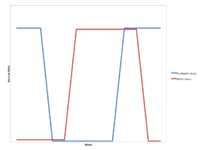
Photo from wikipedia
This paper analyzes the labor supply response of married women as a result of their husbands’ job losses (‘added worker effect’). The study uses panel data from Turkey to test… Click to show full abstract
This paper analyzes the labor supply response of married women as a result of their husbands’ job losses (‘added worker effect’). The study uses panel data from Turkey to test the presence of an added worker effect during the global economic crisis of 2008. Identification is achieved by an instrumental variable approach. In particular, an exogenous variation in the output of male-dominated sectors induced by the crisis is used as an instrument for the husbands’ unemployment. Results show that the probability of a woman participating in the labor force increases by 15–28% in response to her husband’s unemployment. However, the effect is not contemporaneous; rather, it appears with a lag of one quarter and only operates for two quarters. The effect is mainly driven by financially-constrained (less-educated and young) couples, which suggests the prevalence of an income effect in spousal labor supply decisions.
Journal Title: Review of Economics of the Household
Year Published: 2018
Link to full text (if available)
Share on Social Media: Sign Up to like & get
recommendations!